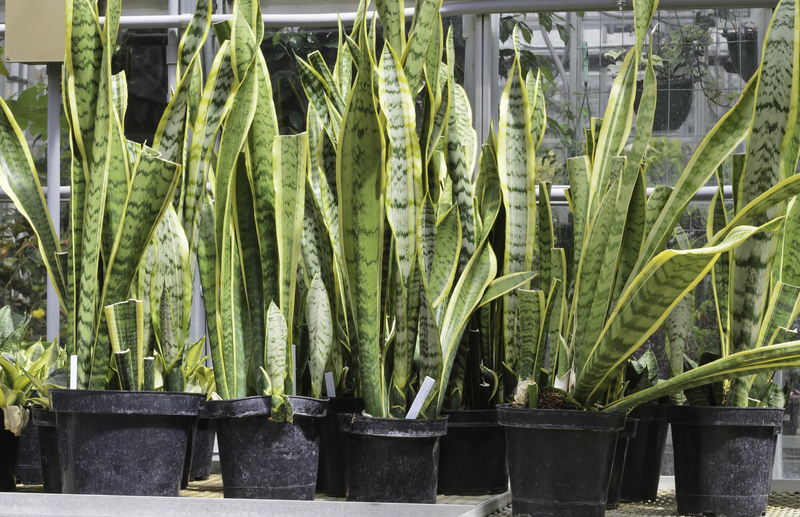From Waste to Wealth: Creating Nutrient-Dense Soil
Posted on 15/09/2025
From Waste to Wealth: Creating Nutrient-Dense Soil
Discover how to transform everyday waste into valuable, nutrient-rich soil that boosts plant growth, improves ecosystems, and supports sustainable agriculture. Learn methods, benefits, and actionable steps for creating your own fertile soil from organic waste materials.
Introduction: The Journey from Waste to Nutrient-Dense Soil
In our ever-growing world, waste management and sustainable agriculture have become critical priorities. Did you know you can turn your daily food scraps and organic waste into a nutrient-dense soil that will revitalize your garden and reduce landfill use? This process, often called upcycling or organic recycling, not only reduces environmental impact but also transforms organic waste into valuable compost and fertile soil. In this comprehensive guide, we'll explore how you can convert waste to wealth by creating healthy, nutrient-rich soil for gardens, farms, and landscapes.

Why Transform Waste into Nutrient-Rich Soil?
Organic waste, when improperly disposed of, can produce methane--a potent greenhouse gas. But when managed correctly, that same waste becomes a rich resource, creating
- Reduces landfill space requirements and greenhouse gas emissions
- Enriches soil structure, improving water retention and aeration
- Enhances nutrient content for better and healthier plant growth
- Promotes biodiversity by supporting beneficial microorganisms, worms, and insects
- Reduces the need for synthetic fertilizers, which can harm the environment
- Saves money on soil amendments and waste disposal costs
Understanding Nutrient-Dense Soil: What Makes It Different?
Nutrient-dense soil isn't just dirt. It's a complex ecosystem rich in essential nutrients such as nitrogen, phosphorus, potassium, and micronutrients that plants need to thrive. This fertile soil is also alive with beneficial bacteria, fungi, earthworms, and organic matter that convert waste into wealth by creating a sustainable, renewable resource for your plants.
Characteristics of High-Quality, Fertile Soil
- Dark, crumbly texture due to high organic matter
- Earthy smell, indicating microbial activity
- Excellent drainage and water-holding capacity
- Balanced pH (typically between 6 and 7 for most crops)
- High levels of organic carbon and essential nutrients
Main Methods to Create Nutrient-Rich Soil from Waste
There are several approaches to transforming waste into nutrient-rich soil. Depending on your available space, resources, and goals, you can choose the method that best fits your needs.
1. Composting: The Foundation of Soil Creation
Composting is the natural process of recycling organic material--such as food scraps and yard waste--into a rich soil amendment. Through the activity of decomposers like bacteria, fungi, and worms, your kitchen and garden waste can be transformed into a dark, crumbly substance called compost.
Types of Composting
- Traditional backyard composting--using a bin or pile to decompose scraps over time
- Vermicomposting--using worms (often red wigglers) to rapidly break down food waste into nutrient-rich castings
- Trench or pit composting--burying scraps directly into garden beds
- Bokashi composting--fermenting waste with special microbes before finishing in soil
How to Compost Effectively
- Collect organic materials--fruit and vegetable peels, coffee grounds, eggshells, grass clippings, leaves, etc.
- Balance carbon and nitrogen--add "greens" (nitrogen-rich) and "browns" (carbon-rich) for optimal decomposition
- Aerate regularly--turn the pile to foster oxygen flow
- Maintain moisture--keep the pile damp, like a wrung-out sponge
- Harvest finished compost--when material is dark, crumbly, and earthy-smelling, it's ready for use
2. Vermiculture: Leveraging Worm Power
Worm composting or vermiculture is an efficient way to process food scraps inside or outside. Red wigglers consume organic waste and produce worm castings, a superior organic fertilizer loaded with microbes and nutrients. Adding worm castings to your garden soil increases plant health, growth, and soil biodiversity.
3. Sheet Mulching (Lasagna Gardening): Soil Building in Layers
Sheet mulching is a no-dig method that transforms yard waste, cardboard, grass, and food scraps into layers of rich, organic soil. Over months, these layers break down, creating a lush, fertile bed for planting.
Steps for Sheet Mulching
- Remove any large weeds from the area
- Spread a layer of cardboard or newspaper to suppress regrowth
- Alternate layers of greens (food scraps, grass) and browns (leaves, straw)
- Water each layer to encourage decomposition
- Top with 2-4 inches of compost or aged manure
4. Biochar: Boosting Soil Fertility with Charred Biomass
Biochar is a form of charcoal made by heating organic material (like crop residue or wood chips) in a low-oxygen environment. When mixed into soil, biochar improves nutrient retention, water holding capacity, and microbial activity. In combination with compost, it creates highly fertile, long-lasting, nutrient-rich soil.
Key Ingredients and Inputs for Creating Fertile Soil
Not every waste material is suitable for soil building. Using the right inputs ensures you create a nutrient-dense, healthy foundation for plant growth.
Acceptable Organic Materials
- Fruit and vegetable scraps
- Coffee grounds and paper filters
- Eggshells
- Grass clippings and yard trimmings
- Leaves, straw, and shredded cardboard
- Manure from herbivores (cows, horses, chickens)
What to Avoid Adding
- Meat, dairy, and oily foods--these attract pests
- Pet waste (cats/dogs)--may contain pathogens
- Invasive weeds or diseased plants
- Synthetic chemicals or plastics
- Large branches or treated wood
The Science of Soil Creation: How Waste Turns into Wealth
As organic waste decomposes, it is broken down by microorganisms into smaller particles. Beneficial bacteria and fungi digest the material, releasing nutrients in forms plants can absorb. Earthworms help by aerating the mix and incorporating organic matter deep into the soil.
The result? Nutrient-rich soil packed with available nitrogen, phosphorus, potassium, and micronutrients--ready to fuel vigorous plant growth. As you continue to add compost and organic matter year after year, your soil structure, fertility, and productivity only improve over time.
Tips to Maximize Soil Nutrient Density
- Keep adding organic matter--even a small amount of food scraps or compost boosts fertility
- Test soil annually for nutrient levels and pH to tailor amendments
- Use cover crops (clover, vetch) to fix nitrogen and prevent erosion
- Mulch beds to suppress weeds and conserve moisture
- Rotate crops to avoid nutrient depletion and soil disease
Benefits of Nutrient-Dense Soil for Gardens, Agriculture, and the Environment
The advantages of creating nutrient-dense soil from waste extend beyond your backyard. Whether you have a home garden or a commercial farm, the ripple effects are profound.
1. Enhanced Plant Growth and Yields
Plants grown in nutrient-rich soil grow faster, healthier, and are more resistant to pests and disease. The improved structure and water retention of organic soil also means less irrigation and fewer crop failures.
2. Improved Food Nutrition
Vegetables and fruits raised in fertile, living soil have higher vitamin, mineral, and antioxidant contents--delivering more nutrition to your table.
3. Reduced Need for Synthetic Chemicals
By continually recycling organic waste into compost, you slash the need for synthetic fertilizers and pesticides that can pollute waterways and harm wildlife.
4. Enhanced Climate Resilience
Soils rich in organic matter store carbon, reduce erosion, and buffer plants from weather extremes. Compost-amended soils also have greater drought tolerance.
5. Closing the Loop on Waste
By redirecting food scraps and yard waste from the landfill, you create a closed-loop system that mimics nature's own cycles--turning yesterday's waste into tomorrow's food in a truly sustainable way.
Common Challenges and How to Overcome Them
- Odors: Add more "browns" (dry leaves, cardboard) if your compost is smelly or wet.
- Slow Decomposition: Chop up materials for faster breakdown; consider a compost aerator or tumbler.
- Pests: Bury food scraps, keep bin closed, and avoid meats and oils.
- Nutrient Imbalances: Test finished compost and supplement with minerals (e.g., rock dust) if needed.
Step-by-Step: How to Start Creating Nutrient-Dense Soil from Waste
- Choose your method--backyard composting, vermiculture, sheet mulching, or another approach.
- Collect your inputs--gather kitchen scraps, yard clippings, and safe organic materials.
- Build your pile or bed, following best practices for moisture, balance, and aeration.
- Monitor and maintain--turn, water, and check temperature where needed.
- Harvest your soil amendment--use finished compost or castings as top dressing, soil amendment, or planting medium.
- Repeat the cycle--keep adding waste to keep the process going year-round.
Inspiring Examples: From Waste to Wealth Around the Globe
Communities worldwide are turning waste into wealth through innovative soil-building projects:
- Urban gardens in New York City use community compost to revitalize vacant lots, producing healthy food for residents.
- Permaculture farms in Australia use sheet mulching and swale composting to create resilient food forests on degraded land.
- Mumbai's decentralized composting systems turn market waste into rich soil for city parks and green belts.
- Africa's "zero waste" farms harness livestock manure and crop waste for organic fertilizer, improving yields and livelihoods.

Frequently Asked Questions (FAQ) about Creating Nutrient-Dense Soil
How long does it take to create nutrient-dense soil from waste?
Depending on method, temperature, and material, composting can take from 2 months (with hot composting) to 12 months (with cold composting or sheet mulching).
Can all kitchen waste go into the compost pile?
Stick to plant-based scraps. Avoid meat, dairy, and oils. Eggshells, coffee grounds, veggie peels, and bread are safe.
Is compost alone enough for healthy soil?
Compost is an excellent soil amendment but works best when integrated into existing soil with other practices--mulching, cover cropping, and crop rotation.
What's the difference between compost and fertilizer?
Compost is organic, slow-release, and improves soil structure and life. Chemical fertilizers deliver quick nutrients but don't feed soil life or build organic matter.
Conclusion: Turning Organic Waste into Wealth for People and Planet
Transforming household and garden waste into nutrient-dense, fertile soil is one of the most powerful steps you can take toward a more sustainable future. Not only will you create richer, more productive gardens--you'll also reduce landfill waste, cut climate emissions, and support the living web beneath your feet.
Start today: Save your kitchen scraps, build or buy a compost bin, and become part of the global movement turning waste into wealth--one handful of fertile soil at a time!
Want to learn more? Explore local composting initiatives, soil-building workshops, and online resources for hands-on tips and community support. Together, we can grow a greener world from the ground up.
```
